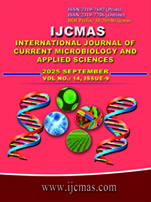


 National Academy of Agricultural Sciences (NAAS)
National Academy of Agricultural Sciences (NAAS)

|
PRINT ISSN : 2319-7692
Online ISSN : 2319-7706 Issues : 12 per year Publisher : Excellent Publishers Email : editorijcmas@gmail.com / submit@ijcmas.com Editor-in-chief: Dr.M.Prakash Index Copernicus ICV 2018: 95.39 NAAS RATING 2020: 5.38 |
Experiments were conducted on specimens of the Brazilian’s Oreochromis niloticus strain infested with Saprolegnia parasitica. This was done in order to determine the effects of this infestation on hematological parameters. To do this, specimens of O. niloticus with a weighing 37,2 ± 12,7 g and having a size of 12.9 ± 0.9 cm, were exposed to concentrations of S. parasitica ranging from 105 to 107 spores/mL, and hematological parameters were measured after 48 h, taking into account controls, infested fish, and sex differences. The results show a decrease in the measured parameters in infected specimens compared to uninfected specimens. However, an increase in mean red blood cell counts and mean corpuscular volume was observed in infected females, as well as increasing in white blood cell counts in males and females. This could indicate an immune response or blood abnormalities, such as leukemia. The decrease in other parameters suggests the presence of anemia and deterioration of the hematopoietic organs, indicating an inflammatory state related to damage caused by infection and stress in the fish. Variations in hematological parameters can be attributed to individual differences, the origin of the fish, and genetic factors. These results highlight the importance of monitoring these parameters to assess the physiological status of farmed fish.
Achuthan-Nair G, Balakrishnan-Nair N. 1983. Effect of infestation with the isopod, Alitropus typus Edwards M. (Crustacea: Flabellifera: Aegidae) on the haematological parameters of the host fish, Channa striatus (Bloch). Aquaculture, 30(1-4): 11-19. https://doi.org/10.1016/0044-8486(83)90147-3
Adenkola A. Y., Ayo J. O., Sackey A. K. B. et Adelaiye A. B., 2009. Hematological and serum biochemical changes in pigs administered with ascorbic acid and transported by road for four hours during the harmattan season. Journal of Cell and Animal Biology, 3(2): 21-28.
Afzali SF, Hassan MD, Sharifpour I, Afsharnasab M, Shankar S. 2015. Experimental Infection of Aphanomyces invadans and susceptibility in seven species of Tropical fish, Veterinary World, 8(9): 1038-1044. https://doi.org/10.14202/vetworld.2015.1038-1044 .
Anderson DP. 2003. Disease of Fishes. Narendra Publishing House, Delhi. pp. 22-73.
Atamanalp M, Yanik T. 2003. Alterations in hematological parameters of Rainbow trout (Oncorhynchus mykiss) exposed to Mancozeb. Turkish Journal Of Veterinary And Animal Sciences, 27(5) : 1213–1217.
Atamanalp M, Keles MS, Haliloglu HI, Aras MS. 2002a. The effects of cypermethrin (A Synthetic Pyretroid) on some biochemical parameters (Ca, P, Na ve TP) of rainbow trout (Oncorhyncus mykiss). Turkish Journal of Veterinary and Animal Sciences, 26(5): 1157-1160.
Atamanalp M, Yanik T, Haliloglu HI, Aras MS. 2002b. Alterations in the haematological parameters of Rainbow trout, Oncorhynchus mykiss, exposed to cypermethrin. Israeli Journal of Aquaculture-bamidgeh, 54(3): 99–103. https://doi.org/10.46989/001c.20318
Bindu Bhaskaran AB. 2011. Haematological and toxicological studies on brackish water fish Etroplus maculatus (Bloch). Philosophy Doctor in Marine Biology, Cochin University of Science and Technology, India, 314p.
Bittencourt JrNS, Gibbs PE, Semir J. 2003. Histological study of post-pollination events in Spathodea campanulata Beauv. (Bignoniaceae), a species with late-acting self-incompatibility. Annals of Botany, 91 (7) : 827-834. http://dx.doi.org/10.1093/aob/mcg088
Blaxhall PC, Daisley KW, 1973. Routine hematological methods for use with fish blood. Journal of Fish Biology, 5 : 771-781. http://dx.doi.org/10.1111/j.1095-8649.1973.tb04510.x
Buckham-Sporer K. R., Weber P. S., Burton J. L., Earley B. et Crowe M. A., 2008. Transportation of young beef bulls alters circulating physiological parameters that may effective biomarkers of stress. Journal of Animal Science, 86(6): 1325-1334. https://doi.org/10.2527/jas.2007-0762
Caruana S, Yoon GH, Freeman MA, Mackie JA, Shinn AP. 2012. The efficacy of selected plant extracts and bioflavonoids in controlling infections of Saprolegnia australis (Saprolegniales; Oomycetes). Aquaculture, 358-359: 146–154. https://doi.org/10.1016/j.aquaculture.2012.06.035
Chodvadiya FJ, Thula KC, Maheshwari DG. 2015. Simultaneous estimation of aspirin and lansoprazole by RPHPLC method. International Journal of Recent Scientifis Research, 6 (4) : 3385-3390.
Diaby V, Yapo AF, Adon AM, Yapi HF, Djama AJ, Dosso M. 2016. Hematological biotoxicity of cadmium sulfate in Wistar rats. Int. J. Biol. Chem. Sci., 10(4): 1765-1772. http://dx.doi.org/10.4314/ijbcs.v10i4.25.
Effiong BN, Alatise SP. 2009. Effect of mold infested feeds on the growth and survival of Heterobranchus longifils. Report and Opinion, 1 (3) : 9-14.
El-Sayed AFM. 2002. Effects of stocking density and feeding levels on growth and feed efficiency of Nile tilapia (Oreochromis niloticus L.) fry. Aquaculture Research, 33: 621– 626. https://doi.org/10.1046/j.1365-2109.2002.00700.x
Fitzsimmons K. 2006. Prospect and potential for global production. In: Tilapia: Biology, Culture and Nutrition. Food Products Press, Lim C. E. & Webster C. D. (Eds), New York, USA, pp. 51-72.
Ghasemi Pirbalouti A, Taheri M, Raisee M, Bahrami HR, Abdizadeh R. 2009. In vitro antifungal activity of plant extracts on Saprolegnia parasitica from cutaneous lesions of rainbow trout (Oncorhynchus mykiss) eggs. Journal of food, agriculture & environment, 7 (2) : 94 – 96.
Han-Ching L., 2006. Produits alimentaires d’origine aquatique : Progrès technologiques au sein des industries alimentaires, impact sur la qualité des produits. Rapport d’experts préalable au rapport de l’académie des technologies. IFREMER, Paris, France, 108p.
Ibrahim HJ, Shahrul AMS, Roswadi Y. 2003. The herpetofauna of Pantai Acheh Forest Reserve. In: Pantai Acheh Forest Reserve: The case for a state park, Chan L .K. (Ed.): 137-144.
Jawad LA, Al-Mukhtar MA, Ahmed HK. 2004. The relationship between haematocrit and some biological parameters of the Indian shad, Tenualosa ilisha (Family Clupeidae). Animal Biodiversity and Conservation, 27(2) : 478-483. DOI: https://doi.org/10.32800/abc.2004.27.2047
Jin Y, Jameel H, Chang H, Phillips R. 2010. Green liquor pretreatment of mixed hardwood for ethanol production in a repurposed kraft pulp mill. Journal of Wood Chemistry and Technology, 30(1) : 86-104. https://doi.org/10.1080/02773810903578360
Joshi PC. 1973. Two identities involving order statistics, Biometrika, 60(2): 428-429. https://doi.org/10.1093/biomet/60.2.428
Khalfallah N. 1993. Influence of Anesthesia on Some Blood Parameters in Farmed Sea Bass Dicentrarchus labrax L. (1758), Bulletin of the National Institute of Marine Science and Technology of Salammbô, 20 : 36-44. https://doi.org/10.71754/instm.bulletin.v20.964
Khoo L. 2000. Fungal diseases in fish. Seminars in Avianand Exotic Pet Medicine, 9(2) : 102-111. DOI: https://doi.org/10.1053/AX.2000.4623
Koné M. 2015. Biosécurité en pisciculture et contrôle du parasite Argulus sp. pour une amélioration de la production du tilapia du Nil Oreochromis niloticus (Linneaus, 1758) de Côte d’Ivoire, Thèse Unique UFR – SN, Université Nangui Abrogoua. 190 p.
Qureshi TA, Chauhan R, Mastan SA. 2001. Hematological investigations on fishes infested with fungal growth. Journal of Environmental Biology, 22 (4) : 273-276.
Rekha C, Faroq A, Lone SA, Ganaie SA. 2014. Hematological and histological investigations on healthy and saprolegnia sp. infected clarias gariepinus (burchell 1822). International Journal of Experimental Pharmacology, 4 (2): 97-100.
Sakande J, Nikiema JB, Lompo M, Nacoulma OG, Bassene E, Guissou IP. 2003. Study of the effect of an isolated anti-inflammatory principle of Borassus aethiopum Mart’s male inflorescences on the kinetics of Creactive protein (CRP). Le pharmacien d’Afrique, 166: 7-11. https://doi.org/10.3923/ajbmb.2013.101.109.
Shah SL, Altindag A. 2004. Haematological parameters of tench, (Tinca tinca L.) after acute and chronic exposure to lethal and sublethal mercury treatments. Bulletin of Environmental Contamination and Toxicology, 73(5) : 911-918. https://doi.org/10.1007/s00128-004-0513-y
Shah SL. 2010. Impairment in the hematological parameters of tench (Tinca tinca) infected by Saprolegnias. Turkish Journal Of Veterinary And Animal Sciences, 34(4) : 313-318. https://doi.org/10.3906/vet-0706-4
Stat Soft, 2005. STATISTICA Version 7.1 for Windows. http://www.statsoft.com.
Steinhagen D, Lukes J, Körting W. 1990. Ultrastructural observations on gamogonic stages of Goussia subepithelialis (Apicomplexa, Coccidia) from common carp Cyprinus carpio. Diseases of Aquatic Organisms, 9(1): 31–36. https://doi.org/10.3354/dao009031
Tavares-Dias M, Moraes FR, Martins ML, Áureo Santana E. 2002. Haematological changes in Oreochromis niloticus (osteichthyes : cichlidae) with gill ichthyophthiriasis and saprolegnioses. Boletim do Instituto da Pesca, São Paulo, 28 (1) : 1-9.
Zaki MS, Fawzi OM, El-Jackey J. 2008. Pathological and Biochemical studies in Tilapia nilotica infected with Saprolegnia parasitica and treated with potassium permanganate. American-Eurasian Journal Of Agricultural & Environmental Sciences, 3 (5) : 677-680.
Zaki M. S., Osfor M. H., Bayumi F. S. & Aboul Gheit F. N., 2003. Impact of low dietry carbohydrate fungi diets on some nutritional and clinicopathological parameters of Tilapia nilotica infected with Saprolegnia parasitica and exposed to copper sulphate. Bulletin of the National Research Centre (Egypt), 28 (2) : 245-257.
Zuo X, Woo PTK. 2000. In vitro haemolysis of piscine erythrocytes by purified metalloprotease from the pathogenic haemoflagellate, Cryptobia salmositica Katz. Journal Fish Disease, 23(3): 227–230. https://doi.org/10.1046/j.1365-2761.2000.00221.x |
 |
 |
 |
 |